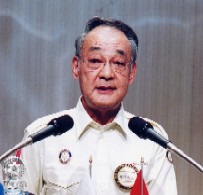RotaryˇˇSponsoredˇˇClearlandˇˇProjectˇˇinˇˇCambodia
May12,2004
Mr.Yoshio Okazaki
Chairman of the District Land MineRemoval Special Committee
 On May 12, the meetingˇÇs speaker was Chairman Yoshio Okazaki of the District Land Mine Removal Special Committee, and member of this club who spoke on the Rotary sponsored Clearland Project in Cambodia: Today, there are some 40 or 50 locations on earth where there are disputes and strife with millions of land mines being buried. The American Department of State says that 60 to 70 million mines are buried, but no one knows for certain how many.
On May 12, the meetingˇÇs speaker was Chairman Yoshio Okazaki of the District Land Mine Removal Special Committee, and member of this club who spoke on the Rotary sponsored Clearland Project in Cambodia: Today, there are some 40 or 50 locations on earth where there are disputes and strife with millions of land mines being buried. The American Department of State says that 60 to 70 million mines are buried, but no one knows for certain how many.
Those countries with the most are Angola, Iraq, Afghanistan and Cambodia. More than half of the land area of Angola is mined with 600 victims annually, and 10 million mines are said to be buried in Iraq, causing heavy damage.
It is recorded that 4 to 6 million mines were buried in Cambodia where we are conducting our work, but according to the organization with which we work, The Halo Trust (A British NGO specializing in the removal of mines) 2 to 3 million are buried there. In 1998, 5 to 6 persons a day, or 2,000 per year were injured by mines, but in 2002, this figure had been reduced to 2 per day, or 800 a year. This proves that land mine removal is progressing.
Land mines are quite lethal, and are said to be effective for 50 to 60 years underground. There is a record that in 1996 / 97 9 or 10 persons became victims of World War ¶ mines.
Roughly speaking, mines can be divided into anti-tank mines and anti-personnel mines. Some land mines fiercely explode, killing or maiming a person, and there are the butterfly types which are dropped from aircraft and hang on branches thus making it difficult for detectors to find them. There are some mines of which 90% is made of plastic.
According to a recent investigation, there are some 350 to 360 types of land mines, manufactured by Russia, China, Vietnam, the U.S.A., etc. As production costs are cheap they are used profusely.
In December 1997, an international treaty to abolish all land mines was signed and last February, Prime Minister pressed a button detonating the last remaining land mine in Japan.
In March 1998, an NPO called ˇĆLand Mines Removal for Humanitarian PurposesˇÇ was formed, with 5 members of this club as founding members, and it is referred to as JAHDS. JAHDS aim is to develop land mine detecting machinery using our advanced techniques. It will be able to detect plastic mines, and will further aid in the rehabilitation of cleared areas.
Our connection with this organization started when our club donated one million yen to it, as takes much time and money to attain its purpose of supporting the development of new mine detecting machines.
The District Governor of that year, Governor Tokumasu took this project up and made it a District wide affair for our 72 clubs forming a Special Committee for Land Mine Removal.
We intend to make this a worldwide affair by promoting it at the Osaka International Convention this May.
JAHDS has received support from our major companies, not only in terms of money and technical assistance but the loan of technical experts and engineers.
Clearance activities started in 2000 and already four areas have been made free of mines.
Lohar village, where we started, is located 60km north of Angkor Wat and was the center of fierce fighting. The second project was Tashiam village, which started in February 2001. The third started in March 2002 and the fourth village was cleared in February 2004.
The villagers have returned and schools have reopened. In order to appeal to Rotarians worldwide, a nationwide Liaison Council for the 34 Districts was formed and many Districts have voiced their support.
We have made small boxes which have been distributed to our clubs to collect donations, and some 5 million yen have been collected in this manner.
From March 2000 to February 2004, 630,000sq.m. of ground have been cleared in which there are 12 villages and 260 families. Project No.5 which started in February 2004 will cost 70 million yen to complete. These villagers have no running water or electricity and are without medical attention. Now that the land has been cleared we are able to enter the villages and provide assistance through our World Community Service projects. Although it is impossible to remove all mines, we would like to reduce victims to zero.